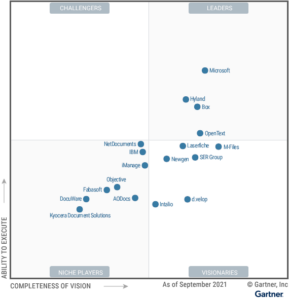NetDocuments, IBM and iManage have come out as the top niche players in the 2021 Gartner Magic Quadrant for content services platforms (CSP), when measured by their ability to execute and completeness of vision. The niche players include legal tech vendor Objective, as well as DocuWare, Fabasoft and AODocs. In the leader’s quadrant for content services platforms is OpenText, along with Box, Hyland and (some way above) Microsoft. The ‘visionaries’ include Intalio; d.velop; Newgen; SER Group; M-Files and Laserfiche.
Gartner assesses all of the entrants ‘strengths’ and ‘cautions’, and we’ll share some of those with you here.
Gartner defines CSPs as the foundational component in an organization for the management and use of content. “CSPs provide a way for employees to retrieve and work with content in a modern, seamless way across devices and organizational boundaries. As such, they are a core component of any organization’s digital workplace strategy,” Gartner says.
However, the core capabilities of CSPs are also records management; process automation and application development; open APIs; security and privacy intelligence; metadata; search; enterprise administration; reporting; mobility and content collaboration.
We’ve picked three lead legal tech CSPs/DMS: NetDocuments, iManage, and OpenText to highlight some of Gartner’s observations re strengths and cautions. And we’ve also shared some key points about Microsoft.
The niche players “must indicate significant market presence that elevates them above other vendors not included in the research.”

NetDocuments
Gartner highlights that NetDocuments operations are primarily in North America and Europe. Most of its clients tend to be either law firms or corporate legal teams within large enterprises, but there is also a presence in other areas such as financial services.
NetDocuments, which leads by its ability to execute, has focused its product on improving findability and collaboration on documents across its own repository, Microsoft 365, and other enterprise document storage locations.
Its strengths include:
- Innovative integration strategy with new work hub: NetDocuments has moved beyond standard integration with Microsoft Office 365.
- Expanded email-centric collaboration: NetDocuments classic strength in email collaboration has been extended now to allow IT to centrally adopt and distribute ndMail capabilities to all Outlook and Gmail users without an additional app or download.
- Native SaaS platform: NetDocuments is a true cloud-native, multitenant SaaS. This provides benefits in terms of continuous improvement and decreased administration and implementation costs.
The cautions are:
- Limited line-of-business integrations: NetDocuments’ built-in business application connectors are limited to Microsoft Power Automate and Salesforce connectors; however multiple third-party integrations are available.
- Workflow limitations: NetDocuments provides very basic workflow capabilities, Gartner says. Organizations looking to deploy complex workflows or to support reports and notifications will need to use a third-party partner (for example, an integration with Microsoft Power Automate is available).
- Limited professional services and legal-centric partner network: NetDocuments’ primary focus on the legal community means that most of its partners are also focused on legal teams and use cases.
iManage
Gartner writes that the majority of iManage’s operations are in North America and Europe, though it also has a presence in Asia/Pacific and Latin America. The majority of its implementations are less than 1,000 users due to an industry and role-specific focus (particularly legal). This installed base is across a range of SMB and enterprise clients.
Its strengths include:
- Outcome-driven case work: Driven by its core strength in legal case work, iManage provides a strong solution for any outcome-driven, case-based work across industries and business functions.
- Policy-driven security: iManage includes a very flexible and powerful mechanism for defining label-based security. This is not common in the CSP market and allows organizations to define complex, policy-driven security rules.
- Native SaaS availability: iManage launched a SaaS version of its iManage Work in 2021, although it has had versions of the product available in the cloud since 2017.
The cautions are:
- Limited process automation: iManage has very limited workflow and process automation compared with other competitors in this market, Gartner says.
- Nascent SaaS offering: While iManage has now released a SaaS version of iManage Work, this is new to the market with limited client case studies. Gartner says it has heard reports from early adopters that there are stability and functionality challenges with the SaaS platform that need to be ironed out.
- Pricing: The vendor’s pricing for large enterprises is high compared with competitors in the CSP market, primarily due to the bundling of other business-specific features.
OpenText
OpenText is a Leader in the Magic Quadrant. Its Content Cloud platform is made up of a range of products including Extended ECM, Core Content and Documentum, which provide a complete set of content services capabilities. Its customer base is international, with a key focus on North America, Europe, Australia and New Zealand. Its customers tend to be large enterprises, with key verticals being financial services, public sector, energy and utilities.
Its strengths include:
- Global presence: OpenText has a true global presence and a strong ecosystem of over 600 international partners to implement and support multinational clients.
- Integration-centric approach: OpenText provides a very strong set of capabilities for integration into leading enterprise line-of-business applications including Microsoft Dynamics, Salesforce, SAP and SAP SuccessFactors.
- Expanding cloud options: OpenText now has a true multitenant SaaS CSP in Core Content. This is new to the market in 2021 and customers should evaluate that the current set of features meet their needs.
The cautions are:
- Customer experience: OpenText customers often express frustration about price negotiation, and unexpected project complexity. OpenText is also the subject of more inquiries from Gartner clients about license audits than any other CSP vendor.
- Overlapping portfolio: OpenText has the largest portfolio of content services offerings in the CSP market due to a growth aided by acquisition strategy. However, much of this is overlapping and integrations between the various services are not consistent.
- Unsuitability for MSEs: OpenText’s primary CSP offerings are not well-suited to MSEs. The architectural complexities, license costs and extensive feature set associated with these products are typically not well-aligned to MSE requirements.
Microsoft
Interestingly, Microsoft, which is the outright leader in the quadrant, is praised for its SaaS platform and third-party ecosystem, as well as the productivity suite integration of SharePoint. Gartner observes: “Microsoft 365 is a SaaS platform benefiting from the continuous development and update cycle this entails. It is a mature service with many options for data residency and additional privacy controls, such as customer-managed encryption keys.”
However, the report says: “SharePoint imposes architectural sizing limits that are not present in other leading CSP platforms. The long-standing site-based topology of SharePoint, coupled with the limits associated with those sites, makes it more challenging to design complex, content-centric processes.”
In a statement yesterday (7 December) sharing the Gartner report, which was formally released in October, Dan Hauck, chief product officer at NetDocuments said: “The completeness of vision and our ability to execute on new –– exclusively cloud-first –– innovations are further proof points of our dedication to deliver dependable innovation to the market.”
For more details you can read the NetDocuments blog. You can also download the Gartner Magic Quadrant report.









